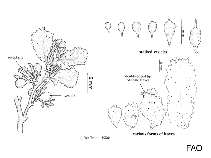Turbinaria ornata (Turner) J. Agardh
Crowded sea bell| Native range | All suitable habitat | Point map | Year 2050 |

|
| This map was computer-generated and has not yet been reviewed. |
| Turbinaria ornata AquaMaps Data sources: GBIF OBIS |
Upload your photos
Google image | No image available for this species;
drawing shows typical species in Sargassaceae.
Google image | No image available for this species;
drawing shows typical species in Sargassaceae.
Classification / Names Common names | Synonyms | CoL | ITIS | WoRMS
Phaeophyceae | Fucales | Sargassaceae
Environment: milieu / climate zone / depth range / distribution range Ecology
Sessile; depth range 0 - 53 m (Ref. 102117). Tropical
Distribution Countries | FAO areas | Ecosystems | Occurrences | Introductions
Indo-Pacific: from Eritrea to South Africa to Madagascar and India, including Western Australia, Andaman, Nicobar and Christmas Islands and from China to the South China Sea, Australia, including Federated States of Micronesia, Fiji, and French Polynesia; from east to Chile, including American Samoa, Samoan Archipelago, Cook and Hawaiian Islands.
Length at first maturity / Size / Weight / Age
Maturity: Lm ? range ? - ? cm
Short description Morphology
Thalli erect and tough, dark brown, attached to rocky substrate by coarse branched holdfasts. Alternating turbinate, fleshy leaves with a terete stalk, crowded along the erect axis; distal end of leaves expanded to form a somewhat circular and fleshy marginal blade, outlined by sharp and coarse teeth; centre of blade concave and conspicuously surrounded, partially or fully, by a crown of teeth; single vesicles may be found at the depressed centre, usually among the leaves at the upper portion of the thallus. Receptacular branches racemose, 5 to 7 mm long, attached to the stalk of the leaves, about 1/3 the distance from the base, their distal portions irregularly forked. Thalli up to 17 cm in height (Ref. 80758).
Used for human consumption, as insect repellant and fertilizer; source of algin, tannins and
phenols (Ref. 80758).
Life cycle and mating behavior Maturity | Reproduction | Spawning | Eggs | Fecundity | Larvae
Main reference
References | Coordinator | Collaborators
Guiry, M.D. and G.M. Guiry. 2009. (Ref. 80701)
IUCN Red List Status (Ref. 130435: Version 2024-1)
CITES status (Ref. 108899)
Not Evaluated
CMS (Ref. 116361)
Not Evaluated
Threat to humans
Harmless (Ref. 80758)
Human uses
Fisheries: commercial
| FishSource |
Tools
More information
Trophic Ecology
Food items
Diet
Food consumption
Ration
Predators
Diet
Food consumption
Ration
Predators
Ecology
Population dynamics
Life cycle
Reproduction
Maturity
Fecundity
Spawning
Eggs
Egg development
Larvae
Larval dynamics
Maturity
Fecundity
Spawning
Eggs
Egg development
Larvae
Larval dynamics
Distribution
Human Related
Aquaculture profile
Stamps, Coins Misc.
Stamps, Coins Misc.
Outreach
References
Internet sources
BHL | BOLD Systems | CISTI | DiscoverLife | FAO(Publication : search) | Fishipedia | GenBank (genome, nucleotide) | GloBI | Gomexsi | Google Books | Google Scholar | Google | PubMed | AlgaeBase | Tree of Life | Wikipedia (Go, Search) | Zoological Record
Estimates based on models
Preferred temperature
(Ref. 115969): 20.6 - 29.1, mean 28 (based on 1626 cells).



